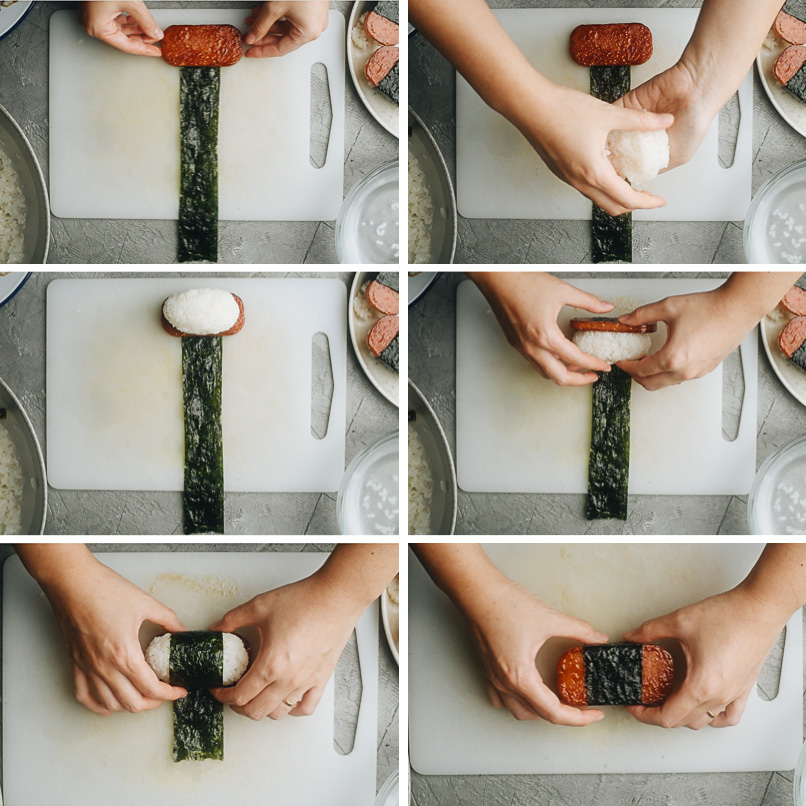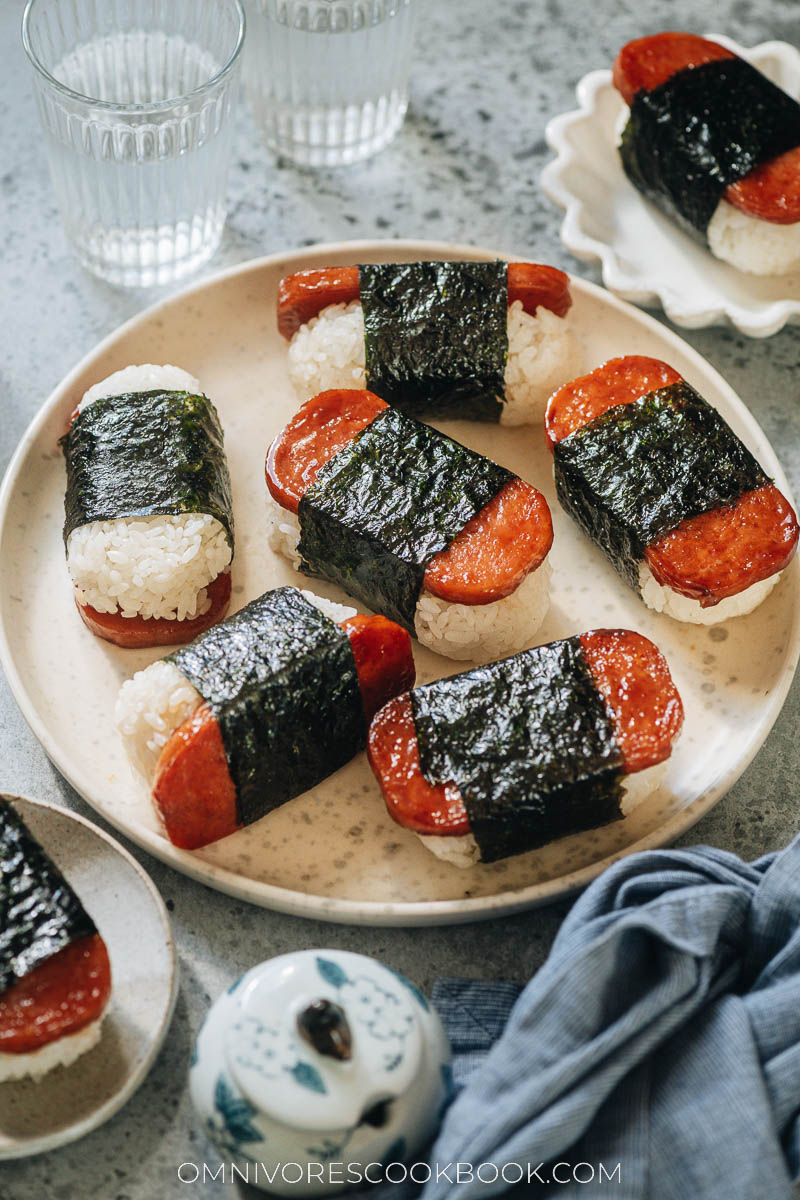
Spam & Chinese cooking
The word Spam might make you think of high-sodium military rations. But in China, Spam is a popular ingredient that people use in comfort food. Spam and pepper stir fry, Spam omelet, Spam ramen, Spam fried rice, or Spam sandwich. You name it.
Spam is also a common ingredient in Chinese Hot Pot and Sichuan Mala Dry Pot – a popular type of Chinese restaurant where you choose a spicy sauce and various ingredients that are cooked in it and then everything is served in a big pot. Every time I go to Mala Pot restaurants with friends, I remember to order a few slices of Spam and it’s always the most popular ingredient in the pot.
Spam is so intertwined with Chinese food culture that I’d never considered Spam a foreign food until I moved the US. Then I started to wonder when it came to China.
After some digging, I found out the following. According to Wikipedia:
“In China, Hormel decided to adopt a different strategy to market Spam, promoting it as a foreign, premium food product and changing the Spam formula to be meatier in order to accommodate local Chinese tastes.”
Apparently, Hormel also decided to name it “luncheon meat” (午餐肉) instead of Spam, to make it sound glamorous. No wonder. Back in old days, Spam was considered a fancy thing that people would serve for dinner on Chinese New Year.

A Common Table Cookbook
This spam musubi recipe is slightly adapted from one in the cookbook A Common Table – 80 Recipes and Stories from My Shared Culture, written by my friend Cynthia Chen McTernan, who is the author behind the award-winning blog Two Red Bowls.
I decided to share her Spam Musubi recipe – a great representation of how Asian food inspired local cuisine and became a part of its culture. Even though I got to know this Hawaiian dish only after moving to the US, it makes me feel nostalgic because of the use of Spam, an ingredient that reminds me of time spent with family and friends.

Spam musubi Ingredients
You only need a few very simple ingredients to make spam musubi:
- Cooked rice
- Spam (I prefer the low sodium type)
- Strips of crispy seaweed (nori)
- Soy sauce and sugar for seasoning
Experiment with sushi rice
The original Hawaiian spam musubi does not use sushi rice, which has added rice vinegar and sugar. But when I make my own spam musubi, I always use sushi rice. The refreshing acidic note cuts the greasiness of the Spam, mellows its saltiness, and works perfectly with the sweet taste.
If you’re feeling adventurous, use the sushi rice recipe from Just One Cookbook. The extra 5 minutes is definitely worth it. Her recipe includes a rice cooker version. Check out this post if you need a detailed instruction on how to make rice on the stovetop.
Seaweed (nori)
Make sure you get the large nori sheet that is about 8” (20 cm) to 9” (22 cm) long. It is usually labeled as sushi nori, yaki nori (roasted seaweed), or laver for Gimbap (if you visit a Korean store). They usually come in large, thin, square packages. And you will need to cut them into strips for this recipe.
How to make spam musubi
Cook the Spam
- Brown the spam until crispy
- Braise the spam with sugar and soy sauce, until the surface is caramelized
It’s very important that you brown the spam slowly and thoroughly. It renders some fat and makes a very crispy crust. Then you will use some sugar and soy sauce mixed with water to quickly braise the Spam. You will end up with a beautifully caramelized dark brown surface that is still chewy and sticky. It’s perfect.

Wrapping the spam musubi
- Place a strip of nori sheet on your working surface, then place the spam at the very end
- Make a ball of rice by pressing it together, then shape it into an oval shape that is similar to the sliced spam
- Roll up the spam and rice using the nori strip
- Make sure to tuck the rice tight enough so the musubi doesn’t fall apart, but not too tight that you tear the nori sheet
- Smear the end of the nori sheet with a bit of water and roll up the musubi, so the nori will stay put.

Tips on shaping the rice
You can use a musubi mold to make the rice pressing process much easier and less messy. I only included the traditional way in the recipe, where you use your hands to press the rice. If you like to DIY, you can even use a Spam can to make your own musubi mold (you need to remove the bottom of the can and cut the can a bit shorter).
To make sure the rice doesn’t stick to your hands too much, make sure to always wet your hands before rolling each musubi.
When you press the rice by hand, it’s important to use proper strength so that the rice is pressed together but not overly mashed. If you don’t press enough, the musubi might fall apart when you bite into it. If you press too hard, the rice texture will be too dense. It takes a bit of practice but once you make a few musubi, you’ll get the idea.
How to store and reheat spam musubi
Spam musubi will taste the best when it’s freshly made and you can appreciate the crunchy spam, tender rice, and crispy seaweed. If you serve it within a couple of hours, it’s OK to store them in a container at room temperature. For longer storage, you need to store them in the fridge. If you store them in the fridge, you should always reheat the musubi in a microwave to warm up the rice, to avoid a tough texture.
I’ve not tried freezing spam musubi, but I think it’s totally OK. You should thaw the frozen musubi in the fridge completely, and reheat them before eating.

More delicious recipes for your next party
- Air Fryer Chinese Chicken Wings
- Curry Egg Salad Wonton Cups
- Pork Lettuce Wrap (San Choy Bow)
- Old-Beijing Fried Carrot Fritters (炸素丸子)
- Chinese Fried Stuffed Eggplant (炸茄盒, Zha Qie He)
This spam musubi recipe is slightly adapted from the cookbook A Common Table – 80 Recipes and Stories from My Shared Culture, written by my friend Cynthia Chen McTernan
Chinese Cooking Made Easy
Are you new to this website? This free email series is a great place to start. I’ll walk you through a few of my most popular recipes and show you how and why they work. You’ll quickly start to cook better Chinese food in your own kitchen.
Watch video

Barter-Worthy Spam Musubi
Ingredients
- 1 teaspoon vegetable oil
- 1 can low-sodium Spam (12 oz. / 340 g can) , sliced into 8 pieces
- 1/4 cup water
- 2 teaspoons soy sauce
- 2 tablespoons sugar
- 4 cups cooked sushi rice (or regular cooked short grain white rice) (*Footnote)
- 3 sheets roasted seaweed (nori) , cut into 8 strips about 2” (5 cm) wide and 9” (23 cm) long
Instructions
- Start making steamed rice (or sushi rice) if you don’t have any already made.
- Heat the oil in a 12-inch (30cm) nonstick or well-seasoned cast-iron skillet over medium heat. Add the Spam slices and cook until browned and crispy on the bottom side, 2 to 3 minutes. Flip and cook until the other side is also browned and crispy, 2 to 3 minutes.
- Whisk together the water and soy sauce in a small bowl. Sprinkle the sugar evenly over the Spam slices, then add the soy sauce mixture. Swirl to evenly distribute, then let the Spam simmer until the liquid is nearly absorbed, 3 to 4 minutes. Flip once in between, so the sugar will melt completely and camalize well. Transfer the Spam slices to a plate to cool.
- To make the sushi: Place one slice of Spam perpendicular to the nori strip on the bottom of the strip (forming a cross shape). Wet the palms and fingers of both of your hands, measure 1/2 cup of rice, and transfer the rice to your palm. Use both hands to firmly press the rice into a ball. Then hold the rice ball with your left hand, with your thumb and the other four fingers to secure both sides, use your right hand to gently press the rice ball into a rectangular shape about the size of the Spam slice. Place the rice on top of the Spam. Roll up the Spam and rice so that the nori sheet wraps around it. Seal the end with a bit of water and place the musubi seam-side-down while you work on the rest. Repeat with the remaining nori strips, Spam slices, and rice. Remember to rinse your hands every time, to minimize rice sticking to your hands.
- Enjoy the spam musubi immediately at room temperature. You can store them in an airtight container or wrap them with plastic wrap and place them in the fridge. To serve refrigerated musubi, warm them in the microwave for 20 seconds or so, to get the best texture.
Notes
- A couple of notes on the rice:
When making sushi rice, always use short grain rice. Medium and long grain rice are less starchy and don’t hold together well when pressed into sushi or musubi.
The original recipe uses regular steamed rice, and so do most Hawaiian Spam musubi recipes.
However, I personally prefer making sushi rice, which contains rice vinegar and sugar. The acid and mild sweetness of the sushi rice complement the salty Spam and create more depth of flavor.
You will use about 3 1/2 cup to 4 cups of cooked rice for this recipe. I found my personal favorite ratio is: slice the Spam into 8 slices, and use 1/2 cup of cooked rice per musubi. In my case, I used 4 cups of cooked sushi rice, which were yielded from 2 rice-cooker cups (180ml per cup) of raw short grain rice.
Nutrition

Did you make this recipe?
I’d love to hear how it turned out for you! Please take a moment to leave a 5-star rating ⭐️ and share your thoughts in the comments further down the page. It really helps others discover the recipe too.

Bill Zigrang
Looking forward to Japanese grilling as soon as the weather improves. Just found a good local source for yuzu kosho. Remember, there’s also reduced-fat SPAM.
Lucille Frank
Many of my favorite Chinese and some Asian recipes have come from your blogs, Maggie. I have been an avid follower over the last year plus since I found your blog. I do have a problem in that I am on a salt restricted diet and admit that I cheat when it comes to fish sauce and hosin, but I can minimize the sodium slightly by using diluted liquid aminos in the place of soy sauce without any loss in the recipes. When I was told I had to minimize by salt uptake, the decrease I had to make in limiting my Chinese and Asian cooking to once a week made me cry, but I stIll make many stir fried meals limiting their salt. That style of cooking that you helped me perfect, leaves my veggies so tender crisp and delicious and the quickly cooked (usually meat) protein cut into small pieces remains tender and full of meat juices! Thanks for the good training you have shown me.
Pennie Gomez
I lived in China for 4.5 years and went to Japan twice. Consequently, I was able to enjoy authentic Chinese and Japanese cooking and it is hard to pick only one as my favorite. Some of my favorites are Lanzhou Beef Noodles, chicken feet (with Harbin beer), pickled pig’s ear, and blood soup (from Hangzhou). In Japan, I really liked puffer fish, miso soup, and tempura vegetables! Oh, now I am super hungry!!! LOL!!
Natalie
Hmm hard to pick favorites… but my grandmother’s Taiwanese-style beef noodle soup or zha jiang mian are definitely up there!
Monica S.
I love Musubi!! My other favorite Asian dishes are Salt and Pepper Shrimp, a won ton with chicken, traditional hot and sour soup, Singapore rice noodles, Szechuan eggplant….anything I can add Chili oil too!!
Jenn
My family loves hot pot. Silkie chicken for the stock base and my kids are happy!
BARBARA RAILEY
I love the Crispy Chinese Honey Chicken because as the name implies it stays crispy and the sauce is scrumptious. Plus for an 80 year old who is new to Chinese cooking it is relatively easy to get a lovely meal prepared.
Sally
I definitely want to try this. Miso Ramen soup, really any noodle soup. Pot stickers!
Audrey Stewart
I would love to win! I really want to learn some different type of cooking besides kid friendly. All the kids are moved out.
Sally
This makes me want to try Spam. Easy recipe. Good directions. I love Miso Ramen soup. I use Miso Dashi and home-made chicken broth. Also Pad Thai, Mongolian Beef and trying to make pot stickers. They taste good, but look sort of floppy.
Karen
Looking forward to trying spam musabi. I’ve heard of Spam but never tried it.
I like anything with noodles – like your simple garlic noodles.
Leonard James Anderson
Hi Maggie!
I love your site and have cooked, with success, many of your fantastic recipes!
My go-to Chinese recipe is one I have tried to replicate from a small, hole-in-the wall restaurant I frequented while in Beijing. The restaurant was very near the Xindadu Hotel, which is near the Beijing Zoo. The menu consited of mostly Chinglish, but with pictures, traditional Chinese characters and prices in Yuan. I chose one that was labeled Mongolian (spelled Mongolean) and was a beef or mutton stir fry consisting of sesame oil. sesame seeds, pea pods, florettes of broccoli, Chinese cabbage, and something that looked like soba noodles.
The dish was so delicious that I ordered it every time, even though there were other interesting ‘pictures’ on the menu. It’s been trial and error for me, but I think I have it down. Someimes I toss in some different veggies, but mostly I stick to the ones above. It is absolutely delicious and especially so when we have good mutton on sale here in NYC!
Keep up the good work Maggie!
Shirley Foey
If you don’t have a musubi mold, you can always remove both ends of the spam can and use that. Makes it just the right size and quite easy! Hope I win one of the cookbooks!
Grace Koshida
Love making crispy pork belly.
Catherine Welker
I have made many of your delicious recipes. They are a non-daunting approach to authentic Chinese cooking.
julia
anything related to dumplings!
Christine
My favorite dish is spicy Sichuan wontons!
Joy
My favorite Chinese dish is the humble tomato and egg stir fry. Tastes like home and full of comfort.
Joan
My mom’s egg rolls are always a hit, and pretty much anything my husband makes; all good Chinese food.
Sj Dc
i was fortunate enough to live in Hong Kong for year and travel to China multiple times eposing me to so many home cooked meals of noodles and baos that are impossible to come by at restaurants..i also have a new found love for the use of lard in cooking and pastries since then!